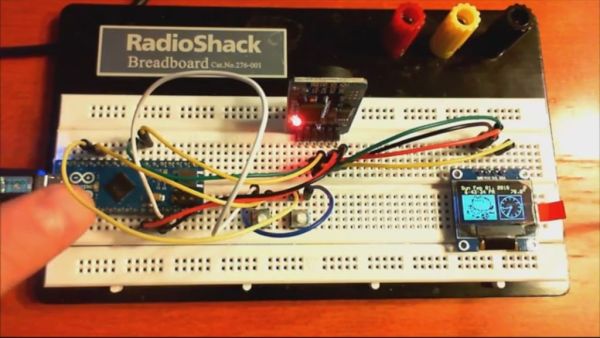UPDATE: I updated the code so that setting the clock does not affect the seconds accuracy – no resyncing of seconds required.
UPDATE: I removed the personal messages from the clock code for the “Pusheen” version in the download links
Video at:: http://youtu.be/ikNw1iLE9vg
Alarm demo video: http://youtu.be/jlZBCuQeswA
This is an OLED alarm clock I built using an Arduino Micro, a tiny OLED 128×64 display using the SSD1306 controller and I2C interface, and a precision DS3231-based real-time clock module with rechargeable battery backup. It features a menu system for setting the RTC (no serial port or USB required)
Two versions are shown – the basic digital/analog clock and a version with “Pusheen” graphics and animation.
It uses the Adafruit graphics libraries and DS3231 library, included in the distribution.
Code for both, including needed libraries, at http://projectmf.homelinux.com/Arduino/ – or download directly from the link below in Step 4.
Step 1: Connect the DS3231 module and 128×64 OLED module to the Arduino
- Connect ground connection from Arduino to the DS3231 RTC module and OLED display.
- Connect +5v from the Arduino to the +5v connections on the DS3231 RTC module and OLED display.
- Connect the pin assigned to the SCL function on your Arduino to the SCL pins on both the DS3231 module and the OLED display.
- Connect the pin assigned to the SDA function on your Arduino to the SDA pins on both the DS3231 module and the OLED display.
- Connect one side of two SPST normally open push buttons to an Arduino ground connection.
- Connect the other side of one push button to pin 8 of the Arduino. This is the time/date/alarm set mode select button.
- Connect the other side of the other push button to pin 9 of the Arduino. This is the time/date/alarm set change button.
- Connect the black wire on a piezo 5 volt buzzer/beeper to the Arduino ground connection. Connect the red wire from the piezo buzzer/beeper to pin 10 of the Arduino. Be sure to use a piezo beeper (NOT a piezo speaker) that generates its own tone when 5 volts is applied. If you use a piezo speaker instead of a piezo beeper, it will only click rapidly when the alarm is triggered. A unit that sounds continuously when power is applied is best, as the code generates a 5Hz interrupted voltage source to pin 10 on its own.
- Download either the regular or “Pusheen” version of the clock code from here or the link in the introduction.
- Install the Arduino libraries in the software distribution .zip file.
- Compile and download the code to your Arduino. The clock and display will start to run.
- Set the clock and alarm per the instructions in the next step.
For more detail: DS3231 OLED alarm clock with 2-button menu setting and temperature display

